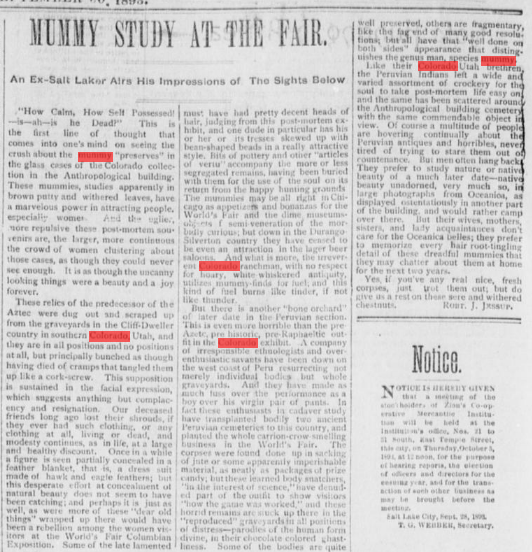“Colorado Mummy” examined by skeptics
MUMMY STUDY AT THE FAIR.
An Ex-Salt Laker Airs His Impressions of The Sights Below
“How Calm, How Self-Possessed! Is he Dead?” This is the first line of thought that comes into one’s mind on seeing the crush about the mummy “preserves” in the glass cases of the Colorado collection in the Anthropological building. These mummies, studies apparently in brown putty and withered leaves, have a marvelous power in attracting people, especially women. And the uglier, more repulsive these post-mortem souvenirs are, the larger, more continuous the crowd of women clustering about those cases, as though they could never see enough. It is as though the uncanny looking things were a beauty and a joy forever.
These relics of the predecessor of the Aztec were dug out and scraped up from the graveyards in the Cliff-Dweller country in southern Colorado, Utah, and they are in all positions and no positions at all, but principally bunched as though having died of cramps that tangled them up like a corkscrew. This supposition is sustained in the facial expression, which suggests anything but complacency and resignation. Our deceased friends long ago lost their shrouds, if they ever had such clothing, or any clothing at all, living or dead, and modesty continues, as in life, at a large and healthy discount. Once in a while, a figure is seen partially concealed in a feather blanket, that is, a dress suit made of hawk and eagle feathers; but this desperate effort at concealment of natural beauty does not seem to have been catching; and perhaps it is just as well, as were more of these “dear old things” wrapped up there would have been a rebellion among the women visitors at the World’s Fair Columbian Exposition. Some of the late lamented must have had pretty decent heads of hair, judging from this post-mortem exhibit, and one dude in particular has his or her or its tresses skewed up with bean-shaped beads in a really attractive style. Bits of pottery and other “articles of virtue” accompany the more or less segregated remains, having been buried with them for the use of the soul on its return from the happy hunting grounds.
The mummies may be all right in Chicago as appetizers and bonanzas for the World’s Fair and the dime museums, but down in the Durango-Silverton country they have ceased to be even an attraction in the lager beer saloons. And what is more, the irreverent man, with no respect for hoary, white whiskered antiquity, utilizes mummy finds for fuel, and this kind of fuel burns like tinder, if not like thunder.
But there is another “bone orchard” of later date in the Peruvian section. This is even more horrible than the pre-Aztec, prehistoric, pre-Raphaeltic outfit in the Colorado exhibit. A company of irresponsible ethnologists and overenthusiastic savants have been down on the west coast of Peru resurrecting, not merely individual bodies but whole graveyards. And they have made as much fuss over the performance as a boy over his virgin pair of pants. In fact, these enthusiasts in cadaver study have transplanted bodily two ancient Peruvian cemeteries to this country, and planted the whole carrion-crow smelling business in the World’s Fair. The corpses were found done up in sacking of jute or some apparently imperishable material, as neatly as packages of prize candy, but these learned body snatchers, “in the interest of science,” have denuded part of the outfit to show visitors “how the gate was worked,” and these horrid remains are
Stuck up there in the “reproduced” graveyards fit all positions of distress – parodies of the human form divine, in their chocolate-colored ghastliness. Some of the bodies are quite well-preserved, others are fragmentary, like the fag end of many good resolutions, but all have that both-sides appearance well-done on that distinguishing retina which distinguishes the genus man, species mummy. Like their Colorado Utah, the Peruvian Indians left a wide and varied assortment of crockery for the soul to take post-mortem life easy on, and the same has been scattered around the Anthropological building cemetery with the same commendable object in view. Of course, a multitude of people are hovering continually about the Peruvian antiques and horribles, never tired of trying to stare them out of countenance. But men often hang back. They prefer to study the nature or native beauty of a much later date – native beauty unadorned, very much so, in large photographs from Oceania, as displayed ostentatiously in another part of the building, and would rather camp over there. But their wives, mothers, sisters, and lady acquaintances don’t care for the Oceanica belles; they prefer to memorize every hair root-tingling detail of these dreadful mummies so that they may chatter about them at home for the next two years.
Yes, if you’ve any real nice, fresh corpses, just trot them out; but do give us a rest on these sere and withered chestnuts.
- Rout. J. Jassup.
- Deseret evening news., September 30, 1893, Part 2, Page 10, Image 10
- About Deseret evening news. (Great Salt Lake City [Utah]) 1867-1920
- http://chroniclingamerica.loc.gov/lccn/sn83045555/1893-09-30/ed-1/seq-10/;words=mummy+Colorado?date1=1836&rows=20&searchType=basic&state=&date2=1922&proxtext=Colorado+Mummy&y=0&x=0&dateFilterType=yearRange&index=19
<script>
(function(i,s,o,g,r,a,m){i[‘GoogleAnalyticsObject’]=r;i[r]=i[r]||function(){
(i[r].q=i[r].q||[]).push(arguments)},i[r].l=1*new Date();a=s.createElement(o),
m=s.getElementsByTagName(o)[0];a.async=1;a.src=g;m.parentNode.insertBefore(a,m)
})(window,document,’script’,’//www.google-analytics.com/analytics.js’,’ga’);
ga(‘create’, ‘UA-61159911-1’, ‘auto’);
ga(‘send’, ‘pageview’);
</script>

Comment